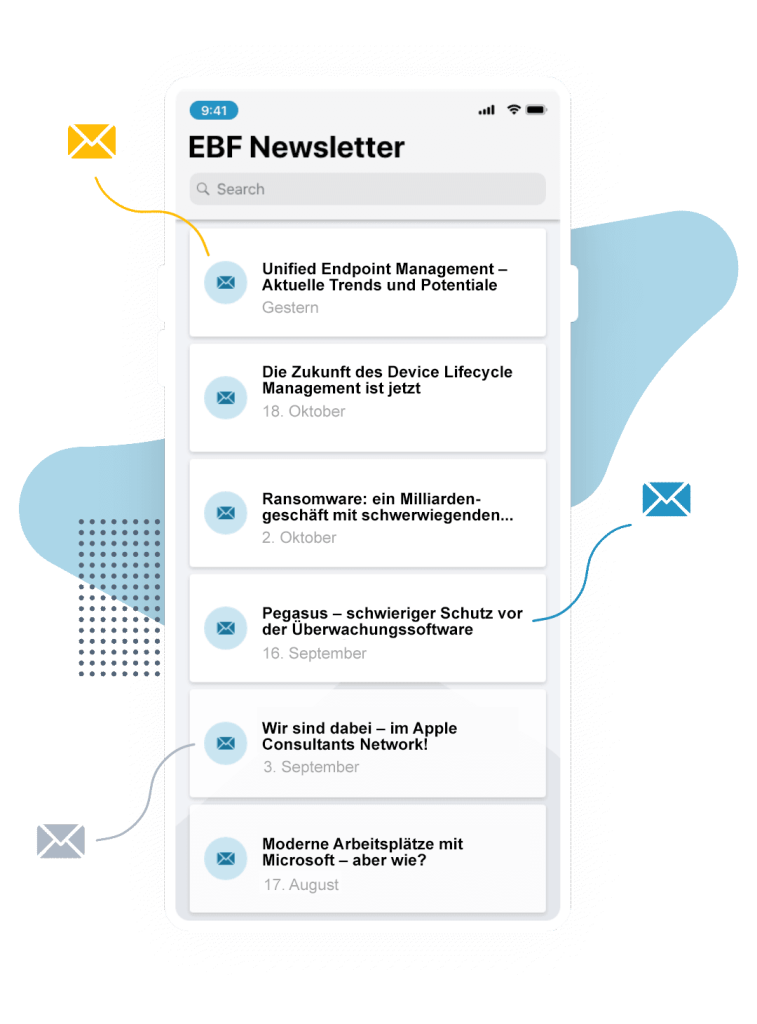At first everyone was talking about “Mobile Application Management” and “Mobile Device Management”, then the term “Enterprise Mobility Management” followed – and now there is more and more talk of “Unified Endpoint Management”. How do the four terms differ and what is behind this development?
Mobile Application Management (MAM)
Mobile Application Management makes it possible to control and manage applications centrally – both corporate apps and public applications. It regulates which apps can be used and can determine this with the help of white and black lists, among other things. Mobile Application Management differs from the term Mobile Device Management in that MAM is exclusively concerned with the management of applications. The management of mobile devices is not possible with this.
Mobile Device Management (MDM)
Mobile Device Management is all about the central management of mobile devices such as smartphones and tablets. Devices can be configured, controlled and secured via a single platform. In case of loss or theft, data on the devices can be deleted.
Enterprise Mobility Management (EMM)
The Enterprise Mobility Management concept combines Mobile Application Management and Mobile Device Management. Here it is possible to manage both mobile devices and their applications and content via a single central platform.
The Device Enrollment programs from Apple, Google and Samsung make it possible to quickly and easily put devices into operation without any configuration effort for the user, while automatically placing the devices under the management of the EMM.
Unified Endpoint Management (UEM)
Unified Endpoint Management now goes one step further and is not limited to mobile devices. It applies to all end devices – from mobile devices to desktop PCs, from iOS and Android to macOS and Windows – and enables their central management via one platform.
The Unified Endpoint Management offers the users of laptops and desktop computers an equally positive user experience during deployment as users of mobile devices: Thanks to Apple DEP and Autopilot for Windows 10, the end devices are immediately ready for operation and all necessary components and applications are installed in accordance with company guidelines without any effort on the part of the user. This means that the devices no longer need to be prepared in advance by the IT department.
What is the background to this development?
The digital workplace is the work model of the future, where boundaries are becoming increasingly blurred. In addition to factors such as changes in corporate culture and management approaches, technologies play an essential role in this. Because only with their help, digital, location- and time-independent working is possible efficiently and securely.
While in the past many isolated applications were used, today it is becoming increasingly important that technologies are networked with each other: On the one hand, employees can execute processes across devices, while on the other hand, IT has little effort and security risks and errors are minimized.
This is exactly where Unified Endpoint Management comes into play, enabling all end devices to be managed via a central platform, thus ensuring greater security, efficiency and a positive user experience. Access can be managed based on intelligent policies and user accounts and data can be effectively protected. A high level of transparency of user activities makes it possible to detect irregularities and attacks at an early stage and to react accordingly. Open interfaces and integration options ensure that the UEM systems can be sensibly linked and used in the long term. Unified Endpoint Management is therefore a great added value for companies and a solution with which companies are well prepared for current and future challenges.
Do the vendors support Unified Endpoint Management?
The leading vendors in this area – MobileIron, Microsoft, VMware, BlackBerry, IBM and jamf – are taking this development into account and have further developed their solutions to enable the central management of all end devices – i.e. Unified Endpoint Management. MobileIron stands for this with its own name, Microsoft’s solution is called Microsoft Intune, VMware’s Workspace ONE, IBM’s MaaS360, jamf’s jamf PRO and jamf NOW and with BlackBerry the name says it all: BlackBerry® UEM.
Crisp Research and Gartner regularly conduct a comparison of UEM vendors. This will help you to decide which solution is the right one for you. We will happy to advise you on the right choice of provider for your company and help you introduce a UEM system, change the system or further exploit your existing solution. For example, stationary devices such as laptops with the Windows 10 or macOS operating system can also be integrated into UEM systems.






